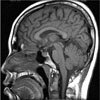Abstract
Multiple endocrine neoplasia type 1 (MEN 1) is an autosomal dominantly inherited syndrome, characterized by the combined occurrence of tumors of the parathyroid glands, endocrine pancreas, and anterior pituitary gland.
The MENIN gene, which is a kind of tumor suppressor gene, is located at the chromosomal locus 11q13. It consists of one untranslated exon and nine exons encoding the menin protein.
We report a case of a 22-yearss-old woman with MEN type 1, who was proven to have a mutation in the MENIN gene. The patient was admitted because of repeated hypoglycemia. The fasting plasma glucose level was 32 mg/dL. Seventy two hours fasting test showed an the insulin/glucose ratio as 0.33. Endoscopic ultrasonography detected multiple masses on the pancreas. The arterial-stimulated venous sampling (ASVS) with calcium showed sudden step up of insulin at the head and tail portions of the pancreas. The sellar MRI showed a pituitary mass that produced prolactin. Instead of a pathologic diagnosis from operational specimen, the genetic analysis revealed a mutation in the MENIN 1 gene (exon 2, 200~201insAGCCC).
Figures and Tables
References
1. Trump D, Farren B, Wooding C, Pang JT, Besser GM, Buchanan KD, Edwards CR, Heath DA, Jackson CE, Jansen S, Lips K, Monson JP, O'Halloran D, Sampson J, Shalet SM, Wheeler MH, Zink A, Thakker RV. Clinical studies of multiple endocrine neoplasia type 1(MEN 1). QJM. 1996. 89:653–669.
9. Wermer P. Genetic aspects of adenomatosis of endocrine gland adenomas in man. A report of five cases and a reviews of the literature. Oncologia. 1962. 15:288–311.
10. Sakurai A, Shirahama S, Fujimori M, Katai M, Itakura Y, Kobyashi S, Amano J, Fukashima Y, Hashizume K. Novel MEN 1 gene mutations in familial multiple endocrine neoplasia type 1. J Hum Genet. 1998. 43:199–201.
11. Benson L, Ljunghall S, Akerstrom G, Oberg K. Hyperparathyroidism presenting as the first lesion in multiple endocrine neoplasia type 1. Am J Med. 1987. 81:731–373.
12. Brandi Maria Luisa, Gagel Robert F, Angeli Alberto, Bilezikian John P, Beck-Peccoz Paolo, Bordi Cesare, Conte-Devolx Bernard, Falchetti Alberto, Gheri Riccardo Gionata, Libroia Alfonso, Lips Cornelius JM, Lombardi Gaetano, Mannelli Massimo, Pacini Furio, Ponder Bruce A J, Raue Frank, Skogseid Britt, Tamburrano Guido, Thakker Rajesh V, Thompson Norman W, Tomassetti Paola, Tonelli Francesco, Wells Samuel A Jr, Marx Stephen J. Guidelines for Diagnosis and Therapy of MEN Type 1 and Type 2. J Clin Endocrinol Metab. 2001. 86:5658–5671.
13. Eriksson B, Skogseid B, Lundqvist G, Wide L, Wilkander E, Oberg K. Medical treatment and long-term survival in a prospective study of 84 patients with endocrine pancreatic tumors. Cancer. 1990. 65:1883–1890.
14. Skogseid B, Rastad J, Oberg K. Multiple endocrine neoplasia type 1, clinical feature and screening. Endocrinol Metab Clin Nor Am. 1994. 23:1–17.
15. Thompson GB. Diagnosis and management of insulinoma. Endocr Pract. 2002. 8:385–386.
16. Tso Annette WK, Lam Karen SL. Insulinoma. Current Opinion in Endocrinology & Diabetes. 2000. 7:83–88.
17. Corbetta , Pizzocaro A, Peracchi M, Beck-Pecoz P, Faglia G, Spada A. Multiple endocrine neoplasia type 1 in patients with recognized pituitary tumors of different types. Clin Endocrinol (Oxf). 1997. 47:507–512.
18. Larsson C, Shepherd J, Nakamura Y, Bloonberg C, Wever G, Wereliuns B, Hayward N, Teh B, Tokin T, Seizinger B. Predictive testing for multiple endocrine neoplasia type 1 using DNA polymorphism. J Clin Invest. 1993. 89:1344–1349.
19. Hoff AO, Cote GJ, Gagel RF. Multiple Endocrine Neoplasias. Annu Rev Physiol. 2000. 62:377–411.
20. Koucaraki MA, Lee JE, Saphiro SE, Gagel RF, SHerman SI, Sellin RV, Cote GJ, Evans DB. Genotype-Phenotype analysis in multiple endocrine neoplasia type 1. Arch Surg. 2002. 137:641–647.
21. Schussheim Debra H, Skarulins Monica C, Agarwal Sunita K, Simonds William F, Burns A Lee, Spiegel Allen M, Marx Stephen J. Multiple endocrine neoplasia type 1. New clinical and basic finding. Trends Endocrinol Metab. 2001. 12:173–178.
22. Guo Sydney S, Wawicki Mark P. Molecular and genetic mechanism of tumorigenesis in multiple endocrine neoplasia type 1. Mol Endocrinol. 2001. 15:1653–1664.
23. Giraud S, Zhang CX, Serova-Sinilnikova O, Wautot V, Salandre J, Buisson N, Waterlot C, Bauters C, Porchet N, Aubert JP, Emy P, Cadiot G, Delemer B, Chabre O, Niccoli P, Leprat F, Duron F, Emperauger B, Cougard P, Goudet P, Sarfati E, Riou JP, Guichard S, Rodier M, Meyrier A, Caron P, Vantyghem MC, Assayag M, Peix JL, Pugeat M, Rohmer V, Vallotton M, Lenoir G, Gaudray P, Proye C, Conte-Devolx B, Chanson P, Shugart YY, Goldgar D, Murat A, Calender A. Germ-line mutation analysis in patients with multiple endocrine neoplasia type 1 and related disorders. Am J Hum Genet. 1998. 63:455–467.
24. Park J-H, Kim I-J, Kang HC, Lee S-H, Shin Y, Kim K-H, Lim S-B, Kang S-B, Lee Ku, Kim SY, Lee M-S, Lee M-K, Park J-H, Moon S-D, Park J-G. Germline mutations of the MEN1 gene in Korean families with multiple endocrine neoplasia type 1(MEN1) or MEN1-related disorders. Clin Genet. 2003. 64:48–53.
25. Friedman E, Sakaguchi K, Bale AE, Falchetti A, Streeten E, Zimering MB, Weinstein LS, McBride WO, Nakamura Y, Brandi ML. Colonality Of Parathyroid Tumors In Familial Multiple Endocrine Neoplasia Type 1. N Engl J Med. 1989. 321:213–218.




 PDF
PDF ePub
ePub Citation
Citation Print
Print








 XML Download
XML Download